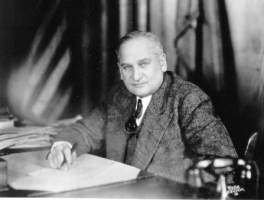The Nonpartisan League (NPL) was a North Dakota political party who reigned local politics for over a decade, beginning shortly after its establishment in 1915. Despite its origins as a faction within the Republican Party, it merged with North Dakota’s Democratic Party in 1956 to form the North Dakota Democratic–Nonpartisan League Party (D-NPL).
The League was principal in establishing several state-owned institutions, in an effort to shift the balance of power away from “big business,” including the Bank of North Dakota in 1919, North Dakota State Mill, and a state-owned railroad.
Several North Dakota Governors were affiliated with the NPL prior to its dissolution through merging with the Democratic Party, most notably Lynn Frazier, Ole Olson, and William “Wild Bill” Langer, who was arguably the League’s most famous member.
While never holding formal office, Edward Patterson was among the most influential figures within the League, headquartering the NPL at his Northwest Hotel until relocating to the Patterson Hotel in 1921, following the Northwest Hotel’s destruction.
Established in 1915, the Nonpartisan League quickly elevated into the state’s dominating political force, ushering in a new progressive movement for the state that opposed the previously commanding big-business centered McKenzie Machine. Just one year after formation, in 1916, NPL-member Lynn Frazier was elected Governor with 79% of the vote. The NPL also won control of both houses after the 1918 election.
The NPL’s dominance came to a temporary end, when in 1921, Governor Frazier was recalled from his position. The NPL wouldn’t regain supremacy until 1932, when William “Wild Bill” Langer was first elected Governor. Langer was forcibly removed from office, before returning again to the role from 1937-1939. He later represented North Dakota in the U.S. Senate until his death in 1959.



